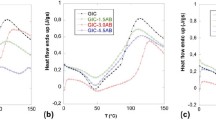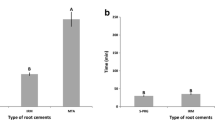Abstract
The effect of glass ionomer cement and resin-modified glass ionomer cement incorporated with chlorhexidine and bioactive glass on antimicrobial activity and physicochemical properties were investigated. The experimental results showed that groups incorporated with 1% chlorhexidine exhibited a significant reduction of optical density values of the bacterial suspension and increased the degradation of Streptococcus mutans biofilm. However, groups incorporated with 10% bioactive glass did not affect the optical density values and the biofilm formation. The mechanical properties of the materials and the polymerization were not influenced by the addition of chlorhexidine. Nevertheless, the compressive strength was lower when the materials were incorporated with bioactive glass. It can be concluded that glass ionomer cements incorporated with chlorhexidine can maintain its mechanical properties as well as reduce early S mutans biofilm formation. Controlled release/sustained release technology may be required to optimize the antibacterial activity of glass ionomer cements incorporated with bioactive glass.
Similar content being viewed by others
References
Theilade J. Dental Plaque and Dental Calculus[M]. In: Lindhe J (ed.) Clinical Periodontology, 2nd ed. Munksgaard, Copenhagen, 1989: 92–128
Loesche WJ. Role of Streptococcus Mutans in Human Dental Decay[J]. Microbiol Rev., 1986, 50:353–80
Burke FIT, Wilson NHF, Cheung SW, Mjor IA. Influence of Patient Factors on Age of Restorations — A Failure and Reasons for their Placement and Replacement[J]. J. Dent., 2001, 29:317–24
Fujii B. The Development of Glass Ionomer Cement[M]. In: Katsuyama S, Ishikawa T, Fujii B, Editors. Glass Ionomer Dental Cement-the Materials and their Clinical Use. Tokyo: Ishiyaku Euro America Inc.;1993:7–14
Imazato S. Bio-active Restorative Materials with Antibacterial Effects: new Dimension of Innovation in Restorative Dentistry[J]. Dent. Mater. J., 2009, 28:11–19
Türkün L S, Türkün M, Erturul F, Ateş M and Brugger S. Long-term Antibacterial Effects and Physical Properties of a Chlorhexidine-containing Glass Ionomer Cement[J]. J. Esthet. Restor.Dent., 2008, 20:29–44
Charles CH, Mostler KM, Bartels LL, Mankodi SM. Comparative Antiplaque and Antigingivitis Effectiveness of a Chlorhexidine and an Essential Oil Mouthrinse: 6-month Clinical Trial[J]. J. Clin. Periodontol., 2004;31:878–84
Xie Z P, Zhang C Q, Yi C Q, Qiu J J, Wang J Q and Zhou J.In Vivo Study Effect of Particulate Bioglass® in the Prevention of Infection in Open Fracture Fixation[J]. J. Biomed Mater. Res. B, Appl. Biomater., 2009, 90:195–201
Allan I, Newman H, Wilson M. Antibacterial Activity of Particulate Bioglass Against Supra- and Subgingival Bacteria[J]. Biomaterials., 2001, 22:168 3–168 7
Zhang D, Munukka E, Hupa L, et al. Factor Controlling Antibacterial Properties of Bioactive Glasses[J]. Key Eng. Mater., 2007, 330–332:173–176
Waltimo T, Brunner T J, Vollenweider M, Stark W J and Zehnder M. Antimicrobial Effect of Nanometric Bioactive Glass 45S5[J]. J. Dent. Res., 2007; 86:754–757
Waltimo T, Mohn D, Paqué F, Brunner T J, Stark W J, Imfeld T, Schätzle M, Zehnder M. Fine-tuning of Bioactive Glass for Root Canal disinfection[J]. J. Dent. Res., 2009, 88:235–8
Hu S, Chang J, Liu M and Ning C. Study on Antibacterial Effect of 45S5 Bioglass®[J]. J. Mater. Sci. Mater. Med., 2009;20:281–286
Young A M. FTIR Investigation of Polymerisation and Polyacid Neutralisation Kinetics in Resin-modified Glass-ionomer Dental Cements[J]. Biomaterials, 2002, 23:328 9–329 5
Namba N, Yoshida Y, Nagaoka N, Takashima S, Matsuura-Yoshimoto K, Maeda H, Van Meerbeek B, Suzuki K, Takashiba S. Antibacterial Effect of Bactericide Immobilized in Resin Matrix[J]. Dent. Mater., 2009, 25:424–30
Ribeiro J and Ericson D. In Vitro Antibacterial Effect of Chlorhexidine Added to Glass-ionomer Cements[J]. Scand. J. Dent. Res., 1991, 99:533–540
Palmer G, Jones F H, Billington R W and Pearson G J. Chlorhexidine Release from an Experimental Glass Ionomer Cement[J]. Biomaterials, 2004, 25:542 3–543 1
Takahashi Y, Imazato S, Kaneshiro A V, Ebisu S, Frencken J E, Tay F R. Antibacterial Effects and Physical Properties of Glass-ionomer Cements Containing Chlorhexidine for the ART Approach[J]. Dent. Mater., 2006, 22:647–652
Imazato S. Antibacterial Properties of Resin Composites and Dentin Bonding Systems[J]. Dent. Mater., 2003;19:449–457
Palenik CJ, Behnen MJ, Setcos JC, Miller CH. Inhibition of Microbial Adherence and Growth by Various Glass Ionomers in Vitro[J]. Dent. Mater., 1991, 8:16–20
Barkhordar RA, Kempler D, Pelzer RRB, Stark MM. Antimicrobial Action of Glass-ionomer Lining Cement on the S Sanguis and S. mutans[J]. Dent. Mater., 1989, 5:281–282
Helena Yli-Urpo, Pekka K. Vallittu, Timo O. Närhi, Ari-Pekka Forsback and Marju Väkiparta. Release of Silica, Calcium, Phosphorus, and Fluoride from Glass Ionomer Cement Containing Bioactive Glass[J]. J Biomater. Appl., 2004, 19:5–20
Gubler M, Brunner T J, Zehnder M, Waltimo T, Sener B and Stark W J. Do Bioactive Glasses Convey a Disinfecting Mechanism Beyond a Mere Increase in pH?[J] Int. Endod. J., 2008, 41:670–8
Ellakuria J, Triana R, Mínguez N, Soler I, Ibaseta G, Maza J, García-Godoy F. Effect of One-year Water Storage on the Surface Microhardness of Resin-modified Versus Conventional Glass-ionomer Cements[J]. Dent. Mater., 2003, 19:286–90
Yli-Urpo H, Lassila LV, Närhi T, Vallittu PK. Compressive Strength and Surface Characterization of Glass Ionomer Cements Modified by Particles of Bioactive Glass[J]. Dent. Mater., 2005, 21:201–209
Guo J, Pan Q, Huang C, Zhao Y, Ouyang X, Duan S. The Role of Surfactant and Costabilizer in Controlling Size of Nanocapsules Containing TEGDMA in Miniemulsion[J]. J. Wuhan Univ. Technol., 2009, 24: 1 004–1 006
Author information
Authors and Affiliations
Corresponding author
Additional information
These authors contributed equally to the work
Funded by the National Natural Science Foundation of China (No. 81070852), the Open Research Fund Program of Hubei-MOST KLOS & KLOBME (200903) and the Science and Technology Project of Wuhan(201161038343-02)
Rights and permissions
About this article
Cite this article
Huang, X., Yang, T., Zhao, S. et al. Anti-biofilm effect of glass ionomer cements incorporated with chlorhexidine and bioactive glass. J. Wuhan Univ. Technol.-Mat. Sci. Edit. 27, 270–275 (2012). https://doi.org/10.1007/s11595-012-0451-1
Received:
Accepted:
Published:
Issue Date:
DOI: https://doi.org/10.1007/s11595-012-0451-1




